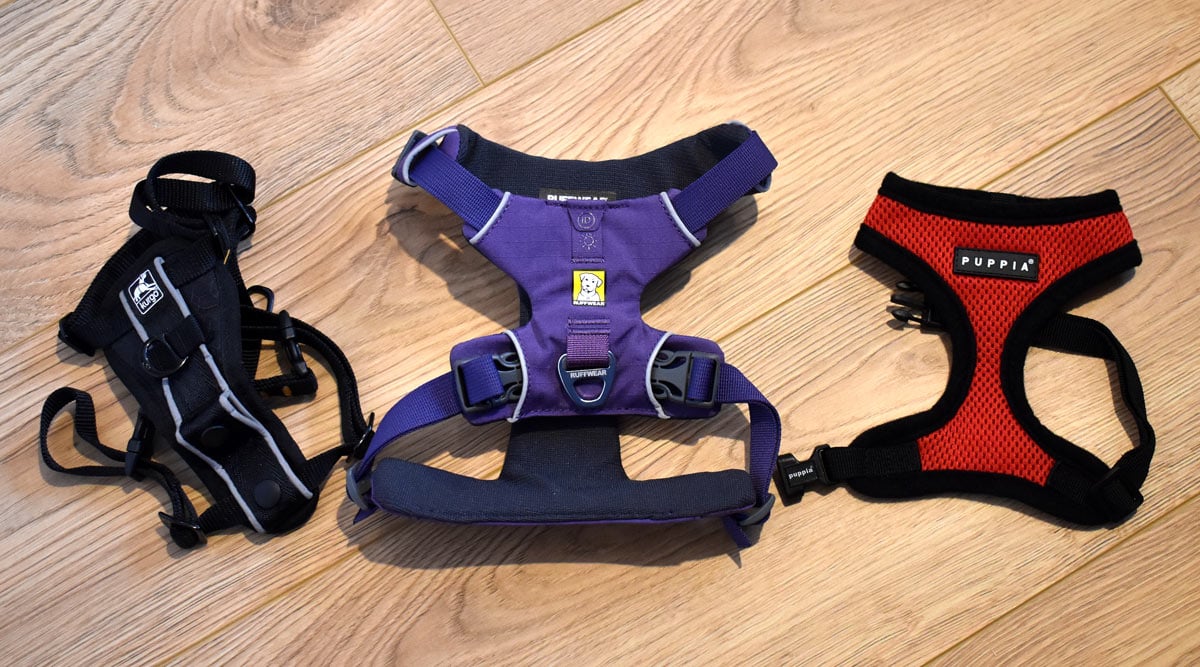
Choosing the best dog harness for your pet can be difficult. There are hundreds of harnesses on the market, and the sad reality is that many we’ve tested simply aren’t up to the job!
To help you find the right option for your pup, we’ve researched, tested, and reviewed the best dog harnesses.
We’ve also included advice from IMDT-accredited dog trainer Rebecca Morello, who has first-hand experience using many of these harnesses both with her clients and when she worked at a large dog shelter.
Top Recommendations
- Our Top Pick: Ruffwear Front Range
- Budget Pick: Kurgo Tru-Fit Smart
- Best for Big Dogs: Embark Adventure
- Best for Escape Artists: Ruffwear Web Master
- Best for Car Travel: Sleepypod Clickit Sport
- Best for Puppies: Puppia Soft Dog Harness
- Alternative Pick: Chai’s Choice Outdoor
Contents
- Top Recommendations
- 7 Best Dog Harness Reviews
- Our Top Pick: Ruffwear Front Range Harness
- Budget Pick: Kurgo Tru-Fit Smart Harness
- Best for Big Dogs: Embark Adventure
- Best for Escape Artists: Ruffwear Web Master
- Best for Car Travel: Sleepypod Clickit Sport Utility Harness
- Best for Puppies: Puppia Soft Dog Harness
- Alternative Pick: Chai’s Choice Outdoor Pet Harness
- How We Chose Our Top Harnesses
- Why Buy a Dog Harness?
- How to Choose a Dog Harness
- Summary
7 Best Dog Harness Reviews
Note: We’ve listed the range of girth sizes available for each harness. These ranges combine the available sizes into a single measurement so you can see whether the harness is suitable for your dog.
Our top recommendation for a dog harness is the excellent Ruffwear Front Range. During our testing, we found that the Ruffwear has a durable and comfortable design with plenty of padding. Many dog owners will also like that it has dual leash attachments and is available in five sizes.
One of the things we liked most about the Ruffwear Front Range is how easy it is to adjust. There are four adjustment points, allowing for a comfortable fit around both the belly and neck. The comfort is further increased by the padding on the belly and chest panels.
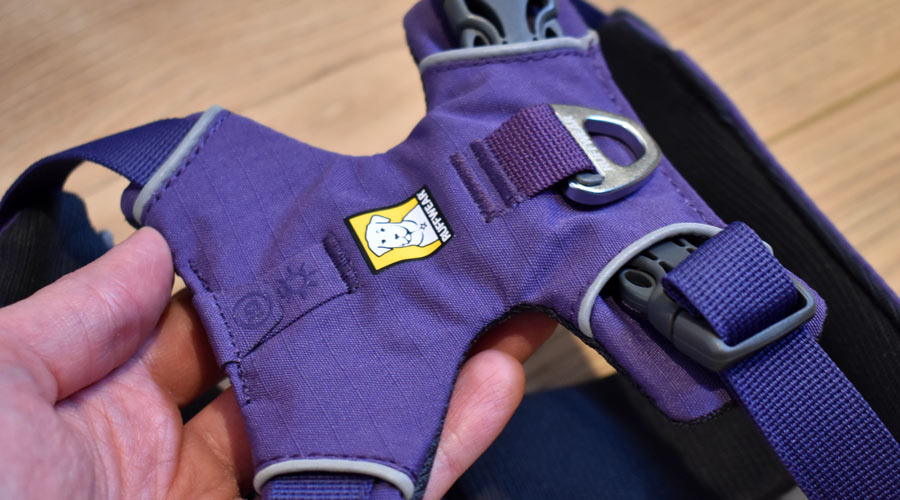
The metal D-Ring on the dog’s back is great for dogs that don’t pull, so this is what we used during most of our testing. The front attachment is made from reinforced webbing and provides more control for light pullers. We would prefer a metal front attachment though, as the webbing loop is unlikely to withstand pulling from the strongest dogs.
A bonus is that the harness comes with an ID tag pocket. We also like that there’s a reflective trim, which makes your dog easier to see in low-light conditions. The only real downside is that the Ruffwear is more expensive than most harnesses, but we think it’s worth the money.
During our testing, we found that he Ruffwear Front Range is an excellent dog harness. The padding makes it comfortable for your dog to wear – even if they pull. It’s also durable and has four points of adjustment for a snug fit.
- Type: Front and Back-Clip
- Breast Girth Sizes Available: 13 inches – 42 inches
- Price Range: $$$
- Reinforced stitching and a durable design
- Easy to adjust and comfortable to wear
- Reflective trim and ID tag pocket
- More expensive than most other harnesses
- Webbing front leash attachment isn’t as strong as the metal rear D-ring
If you want a cheaper alternative to the Ruffwear Front Range, then the Kurgo Tru-Fit Smart Harness is our top recommendation. We were impressed with this harness during our testing and think it’s a solid option for most dogs, although it can’t quite match the Ruffwear’s comfort.
Like the Ruffwear, the Kurgo is a dual-point attachment harness with wide chest padding and a machine-washable design. We found that the harness is durable and feels well-made despite being cheaper than the Ruffwear. We also like that it’s highly adjustable, as there are five adjustment points to get a comfortable fit.
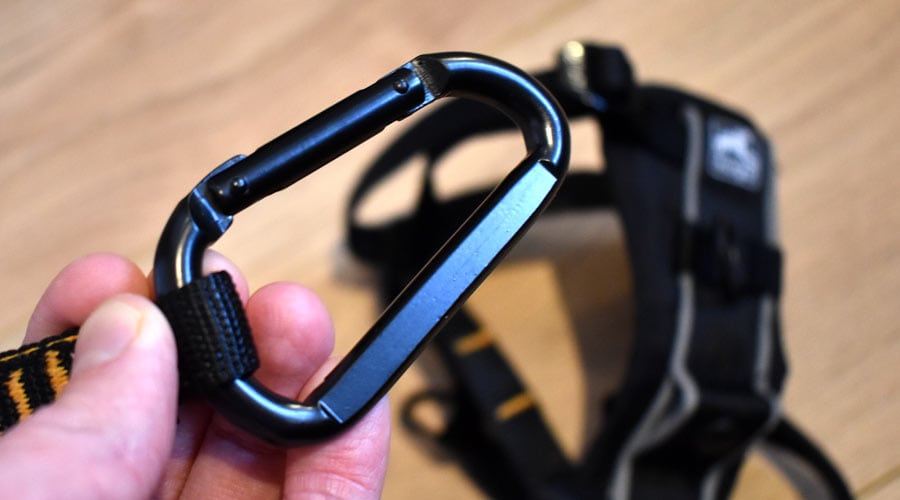
One of the advantages of the Kurgo over the Ruffwear is that it has a stronger front leash attachment. Unlike the Ruffwear, which uses reinforced mesh, the Kurgo has a proper clip. It’s also suitable for slightly smaller dogs, with a minimum chest girth of just 12″.
The main reason we didn’t rate the Kurgo above the Ruffwear is that the padding doesn’t extend as far around the neck. This means it’s more likely to cause chafing, particularly in short-haired breeds, such as Greyhounds.
We think the Kurgo is an excellent dual-attachment dog harness that’s available for a great price. It has less padding than the Ruffwear, so we don’t recommend it for short-haired breeds. But it’s still a comfortable and highly adjustable dog harness for most breeds.
- Type: Front and Back-Clip
- Breast Girth Sizes Available: 12 inches – 44 inches (make sure you also measure your dog’s neck)
- Price Range: $$
- 5 adjustment points to get a comfortable fit
- Strong and durable
- Machine washable
- Less padding than the Ruffwear which makes it less suitable for short-haired breeds
The Embark Adventure is another standard harness that we think deserves a place on this list. During our review process, we liked that it has padding in the most vulnerable areas, comes with both front and rear leash attachments, and includes a handle for when you need instant control of your dog.
In many ways, the Embark is similar to the Ruffwear Front Range. It has four adjustment points, which we found made it easy to get a comfortable and snug fit on your dog. We liked that the chest padding extends around the neck for added comfort too.
In terms of durability, we think the Embark is a match for almost any harness in its price range. The nylon is tough and built to last, plus we also liked that the front and back D-rings are reinforced and durable.
We did find a few issues with this harness though. The Embark Adventure’s durable design means it feels quite bulky, which could be an issue on warm days. The smallest size only goes down to a chest girth of 18″ too, so the Ruffwear or Kurgo are a better option for tiny dog breeds. On the other hand, it goes up to 45″, which is bigger than many harnesses.
We found that the Embark Adventure is a durable dog harness that provides excellent value. It’s easy to adjust, has plenty of padding, and two leash attachments. We also think it’s a great option for bigger dog breeds.
- Type: Front and Back-Clip
- Breast Girth Sizes Available: 18 inches – 45 inches
- Price Range: $$
- Durable dog harness for a great price
- Two leash attachments
- Four adjustment points
- Not suitable for the smallest dog breeds
- Quite bulky and warm
If you need a harness for a dog that has a habit of slipping free while on a walk, the Ruffwear Web Master is our top pick. We found that this is a durable harness that shares many features with the Ruffwear Front Range, but the addition of an extra stomach strap makes it much harder for a dog to back out of the Web Master.
Aside from its extra strap, we found the Web Master to be a durable harness that’s comfortable to wear. We like that there are five adjustment points, making it easy to get a snug fit on most dogs.
A bonus is that the Web Master comes with a strong handle on the back. If you’re on a walk and need quick control, having the option to use a handle (that’s strong enough!) can be really useful.
Unlike the Front Range, the Ruffwear Web Master only has a single rear leash attachment. However, we found that this is strong and durable, so it’s trustworthy even when walking a dog that pulls. We also found that it’s quite fiddly to adjust, and it can’t be machine-washed, although these are minor issues considering the quality of the harness.
The Ruffwear Web Master is our top harness for escape artists. It’s a durable and comfortable harness with plenty of padding, plus the extra stomach strap makes it almost impossible for dogs to escape from.
- Type: Back-Clip
- Breast Girth Sizes Available: 13 inches – 42 inches
- Price Range: $$$
- Extra strap prevents dogs escaping
- Strong handle for quick control
- High-quality and durable design
- Relatively expensive
- No front leash attachment
The Sleepypod Clickit Sport is the only harness on this list that’s crash-test certified by the Center for Pet Safety, so it’s our top pick for a car harness. The Sleepypod isn’t cheap, but if you need a car harness for dogs, then it’s one of the safest options.
As you would expect from such an expensive harness, we found that the Sleepypod is built to a high standard. The harness itself is made from ballistic nylon for excellent durability. There’s a leash D-Ring on the back that’s very strong and durable, while we like that the vest has plenty of padding for comfort and to absorb energy in a crash.
Along with its crash-safety features, the Sleepypod Clickit comes with reflector strips for night time visibility. It’s also a wide vest that provides both comfort and security for dogs that pull.
Keep in mind that this is a much thicker and more restrictive dog harness than most other options though. This is vital for crash safety, but means we don’t recommend the Sleepypod for long walks, hiking, or exercise in warm weather. It’s also not machine washable, so we think it’s best used as a car-only harness.
Note: The Sleepypod isn’t suitable for breeds with small necks, such as Salukis, Borzos, Greyhounds, Whippets, and Afghan Hounds. You can view videos of the crash test here.
If you’re looking for the best dog harness for car rides, the Sleepypod Clickit is our top pick. It’s crash-test certified by the CPS, and is made with strong materials and extra vest padding to improve your dog’s chances in a crash. We found that it’s too bulky and restrictive for anything other than short walks though.
- Type: Back-Clip
- Breast Girth Sizes Available: 16.5 inches – 40 inches
- Price Range: $$$$
- Excellent car safety as it’s the only harness crash-test certified by the CPS
- Padded vest and strong construction
- Reflective for improved visibility
- Too restrictive for long walks
- Expensive
- Not machine washable
If you’re looking for a relatively cheap dog harness that’s still durable and comfortable, then the Puppia Soft Dog Harness is one of our favorite options. We also think the Puppia is a great choice for puppies, as it’s both soft and inexpensive to replace once your dog outgrows it.
The Puppia is made from 100% polyester. During our testing, we found that this provides a soft feel without the hard straps found on some harnesses. It’s not the most padded harness we’ve reviewed, but it provides reasonable comfort even on longer walks. A bonus is that it’s machine washable on a gentle cycle – although the company recommends hand washing if possible.
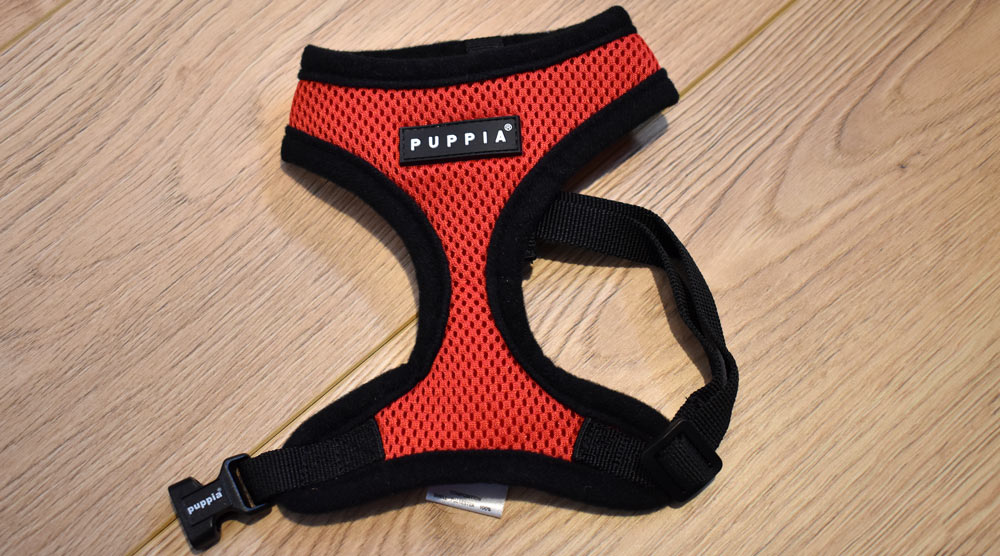
One of the great things about the Puppia is the range of sizes available. The smallest is suitable for dogs with a chest girth of just 9″, which is smaller than any other harness on this list. This makes it one of the best harnesses for small dogs (or puppies) – especially as small breeds typically don’t need such a strong harness.
A downside is that it isn’t as adjustable as some of the best dog harnesses on this list. While the chest belt can be adjusted, the neck is a fixed size. For this reason, make sure you check your dog’s measurements carefully before buying. For dogs with unusual body shapes or larger heads (such as French Bulldogs), we recommend the more adjustable Puppia RiteFit instead.
We think the Puppia Soft Harness is one of the best cheap dog harnesses available at the moment. It’s not the most padded, durable, or versatile, but it’s great for small dogs or puppies.
- Type: Back-Clip
- Breast Girth Sizes Available: 9 inches – 41 inches
- Price Range: $
- Great for small dogs or puppies
- Soft design for extra comfort
- Excellent price
- No neck adjustment buckles
- Not as durable as more expensive options
If you’re looking for a cheaper version of the Ruffwear with more padding than the Kurgo, we found the Chai’s Choice to be an excellent harness. It’s a stylish dual-attachment harness that’s available in five sizes – plus it’s considerably less expensive than the Ruffwear.
During our tests, we found that the Chai’s Choice is a durable and tough harness. The wide chest and stomach padding help prevent rubbing and soreness, while the strong zinc-alloy D-rings provide secure leash attachment points. Additionally, the outer layer is made from durable and scratch-resistant material, so we think the harness is likely to last a long time.
A downside of the Chai’s Choice is that it doesn’t have a proper handle like many of the harnesses on this list. This might not be a problem for smaller dogs, but we’ve found a strong handle can be useful in emergency situations. It’s also listed as suitable for car travel, but it’s nowhere near as safe as crash-tested options such as the Sleepypod.
We found that the Chai’s Choice harness is great for everyday walking or hiking. It’s comfortable, durable, and has both front and back leash attachments. It doesn’t have a handle though, which many owners find helpful.
- Type: Front and Back-Clip
- Breast Girth Sizes Available: 13 inches – 42 inches
- Price Range: $$
- Durable harness with high-quality construction
- Comfortable padding
- Front and back leash attachment points
- No proper handle
How We Chose Our Top Harnesses
As dog owners, everyone at The Dog Clinic has had lots of experience with a variety of harnesses. Our team also includes dog trainers and experts who have worked at dog shelters, which means they have a lot of experience with almost every harness on the market.
We used this experience, along with buyer reviews, to narrow down our options. We then bought a selection of the top harnesses to test.
Why Buy a Dog Harness?
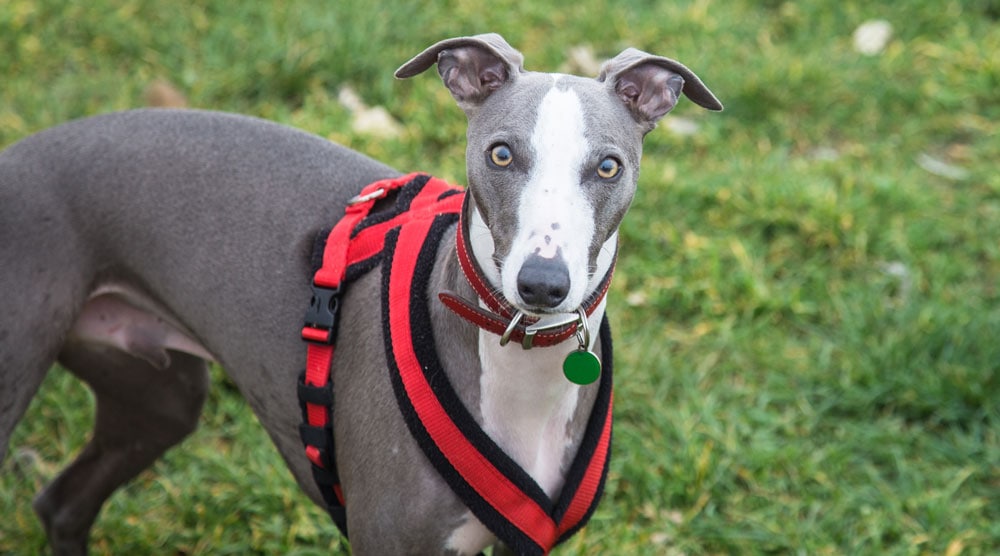
At The Dog Clinic, we believe dogs should be walked with their leash attached to a harness, not to the collar. Of course, dogs should still wear a collar with an ID tag, but this shouldn’t be used for the leash attachment.
The main problem with a flat collar is that sudden pulling can cause severe neck injuries. For example, if your dog sees a squirrel and lunges to chase it, all the force required to hold them back is directed onto the delicate trachea and neck.
It’s not just jerky movements that can cause damage though. Even relatively mild pressure that’s applied continuously throughout a walk can cause back problems or hypothyroidism (due to trauma to the thyroid gland in the neck).
In contrast, the best dog harnesses spread the force of pulling across your dog’s chest and shoulders, rather than concentrating it on the neck. This can prevent back injuries and stop your pooch from choking on a dog walk. A harness can also give you control over your dog without worrying about hurting your dog’s neck.
It’s important to point out that harnesses can be dangerous too. “Many harnesses are still designed with a front strap that sits across the shoulder blades,” says Rebecca Morello, IMDT dog trainer.
“Over time, this can lead to mobility issues, as the strap restricts a dog’s natural movement and puts pressure on bony points of the body,” she adds. We’ve purposefully avoided these types of harnesses in our top picks above.
Similarly, if a harness isn’t fitted correctly, then it can restrict movement and lead to long-term injuries and pain. The chances of this happening are reduced if the harness is the right size and not over-tightened though.
How to Choose a Dog Harness
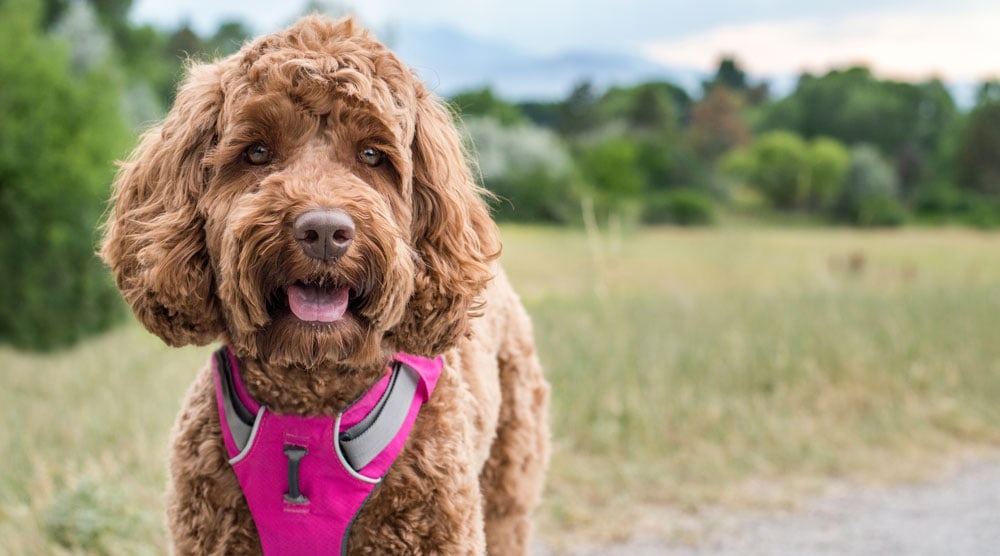
When buying a harness, the most important considerations are comfort and durability. Your dog shouldn’t be restricted or uncomfortable when wearing it, and the harness needs to withstand outdoor weather conditions. Here’s an overview of the most important considerations.
Harness Design
There are several common designs for a dog harness. The right option mainly depends on your dog’s preferences.
- Step-in harnesses allow your dog to “step” between the harness straps, rather than passing it over the head. This makes step-in harnesses a great choice for dogs who hate things going over their head, or breeds with large heads in relation to their body (such as the French Bulldog). However, some dogs don’t enjoy having their legs “manhandled” into the correct position.
- Standard harnesses go over the dog’s head and have a snap buckle around your dog’s body. They are the most common and are a solid choice for most dogs. Examples include the Ruffwear Front Range and Chai’s Choice Outdoor.
- Escape-proof harnesses typically have an extra strap across the belly, which stops the dog from backing out. The Ruffwear Web Master is a great example of this type of harness.
On a side note, you’ll often see harnesses described as “no pull.” Make sure you find out exactly what this means before you buy. It’s often a meaningless marketing term, or used when a harness has a front leash attachment, but is occasionally used for aversive harnesses that cause pain.

The Dog Clinic firmly supports positive dog training. For this reason, we haven’t included choke chains, shock collars, or prong collars in the list above, as we strongly believe these should never be used. We also haven’t including tightening harnesses, such as martingales.
Durability
When choosing a dog harness, we think that durability is a key consideration. A harness needs to cope with mud, rain, snow and whatever else your dog is likely to walk in.
During our testing, we’ve found that the seams and attachment points – especially the D-Ring for the leash – are often weaknesses. So, ideally you should look for harnesses that have extra reinforcement in these areas so they don’t break when your dog pulls.
Quick-release buckles or Velcro straps also need to be safe and reliable. It’s vital that these don’t come loose when you need them most!
Comfort
We’ve found that there are three common issues when it comes to harness comfort:
- A lack of padding in key areas, which is common in cheaper harnesses.
- Harness designs with a single strap across both shoulder blades, which often restricts movement and can lead to discomfort over time.
- Harnesses that move or sag, even when adjusted correctly.
To fix the first issue, we recommend harnesses with extra padding in areas that are likely to rub, such as the “underarms.” Padding increases comfort for your dog and makes the harness less likely to cause chafing.
While padding is always important, it’s essential if you’re going to be using the harness for long walks. The longer your dog is wearing the harness, the more likely it is to cause chafing or rubbing.
Of course, getting an accurate fit is also vital for preventing rubbing. That’s why we also recommend buying a harness with multiple adjustment points, so you can get a snug fit based on your dog’s unique body shape.
Unfortunately, it can be harder to find the right harness for dogs with unusual shapes. “Many standard harnesses do not properly fit dogs with disproportionate bodies, such as dachshunds and cross breeds with small heads and deep chests,” says Rebecca Morello, IMDT. “If you are struggling to fit the harnesses in this article, the company Perfect Fit Harness makes harnesses that can be ordered in three separate pieces to fit a variety of body shapes.”
Size
Harnesses are made with varying styles, so it’s vital to take accurate measurements and consult the manufacturer’s size chart before buying.
Most people know that a dog harness shouldn’t be too tight, but a harness that’s loose is also a risk. “If the harness is too loose, the dogs can slip out of it, which could be very dangerous, especially if near a road,” says Rebecca Morello, IMDT dog trainer. Incorrect sizing can also cause chafing and discomfort.
The majority of harnesses only require you to know the girth of your dog’s ribcage, which can be measured with a soft measuring tape. You’ll also need a neck measurement for some harnesses (such as the Kurgo).
Once you receive the harness, it’s vital to ensure it’s adjusted correctly. “You should be able to fit two fingers under the harness, comfortably but not easily,” says Morello. “Check for this gap around your dog’s neck, back, and stomach. Regularly check the harness for wear and tear, and to ensure no sharp seams or plastic parts are exposed.”
Tip: If you have a breed with a unique shape, such as a Pug, Greyhound, Corgi, French Bulldog or English Bulldog, you need to be particularly careful about which you choose. For Dachshunds specifically, take a look at our guide to the best harnesses for dachshunds. We’ve also written a guide to harnesses for huskies.
Types of Dog Harness Attachments
There are two main types of harness – front and back-clip. The right option depends what you want from a harness and the behavior of your pet.
- Back-Clip Harness. As the name suggests, a back-clip harness has a leash attachment on the dog’s back. They are typically the easiest for dogs to adapt to wearing. One of the great things about this type of harness is that the leash is less likely to become caught on the dog’s front legs.
- Front-Clip Harnesses. This type of harness has a leash attachment at the front of the dog’s chest. A front leash attachment can reduce the strength of pulling without pain, as the leash takes the dog slightly off balance. However, if the dog pulls continuously on daily walks, this off-balance gait can lead to mobility issues in the long run – especially for young puppies. Therefore, we only recommend using the front-clip on its own if the dog usually walks without tension, or for training loose leash walk. A better option is a dual leash harness with the leash attached to both front and rear D-rings.
- Dual-Clip Harnesses. Some harnesses come with both front and back leash connection points. These are often used when an owner needs more control during training, with the back attachment for guiding during normal walking and the front used for more control if the dog starts to pull.
Can the leash attachment positions really help with pulling though? “Harnesses are not a replacement for training, but can give more control if a dog is pulling,” says Rebecca Morello, IMDT dog trainer. “A back clip is the most comfortable for dogs to be walked on. But for strong pullers, the lead can also be attached to the front D-ring to help reduce the force of pulling.”
“However, I only recommend the front clip if the lead is also attached to the back D-ring,” says Morello. “This ensures the dog isn’t pulled at a constant angle. The front clip can also be used on its own when you are doing loose leash training with your dog, to signify the difference between training and normal walks.”
Other Considerations
Here are few more considerations when choosing a dog harness:
- Machine Washable. Dog harnesses get dirty fast, but some can only be hand-washed. If you’re going to be washing the harness regularly, you may want to look for one that’s machine washable.
- Extra Features. Some harnesses come with extra features. Common examples include a handle (for quickly getting control in dangerous situations), seat belt attachments, and quick-dry materials. Many also have reflective strips – although if you do lots of night-time walking you may want to consider an LED collar.
- Price. The cheapest harnesses can cost as little as $10, while premium options cost $100+. For most dog owners, the sweet spot is around the $30-50 range. These harnesses tend to be durable enough for daily walks, but without the high cost.
Be aware that fearful dogs may initially find it difficult to wear a harness. “Although harnesses are safer and more comfortable than a collar, they are also more invasive to put on,” says dog trainer Rebecca Morello. “Often, well-meaning dog parents restrain or chase their dog to try and get it on them, without the required slow and positive introduction to the harness.”
If your dog runs away, or shows other signs of anxiety when you try to put his harness on, read our guide to teaching a fearful dog to enjoy wearing a harness.

Plenty of harnesses are advertised as being suitable for cars – but many of them won’t provide much protection for your dog in a crash. If you’re buying a car harness, make sure you choose one that’s strong enough to handle a high-impact collision and has been independently crash-tested (you can view a list of the Center for Pet Safety Crash Tested Harnesses here).
Summary
Our top recommendation for a dog harness is the Ruffwear Front Range. During our tests, we found it to be a highly durable and well-padded harness, with easily adjustable buckles and dual-attachment points.
If you’re looking for a slightly cheaper option with many of the same features, the Kurgo Tru-Fit is a great alternative. And for escape artists, the Ruffwear Web Master is a brilliant option.
Do you have any questions about choosing the best dog harness for your pet? Let us know in the comments – we’ll do our best to help!








I have bought Ruffwear and all I can say it’s very worth it even if it’s a little bit expensive.